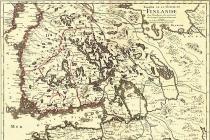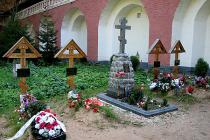Plan
Introduction
1 Foreign policy situation on the eve of the war
2 Declaration of war
3 Swedish goals in the war
4 Progress of the war
5 Negotiations and peace
6 Sources
Bibliography
Russo-Swedish War (1741-1743)
Introduction
Russian-Swedish War 1741-1743 (Swedish: hattarnas ryska krig) - a revanchist war that Sweden started in the hope of regaining the territories lost during the Northern War.
1. Foreign policy situation on the eve of the war
In Sweden at the Riksdag 1738-1739. The party of “hats” came to power and set a course for preparing a war with Russia. She was actively supported by France, which, in anticipation of the death of the Austrian Emperor Charles VI and the subsequent struggle for the division of the Austrian inheritance, tried to bind Russia with a war in the North. Sweden and France, through their ambassadors in St. Petersburg, E.M. von Nolcken and the Marquis de la Chetardie, tried to prepare the ground for the successful completion of the planned war by establishing relations with Princess Elizabeth. The Swedes tried to get a written confirmation from her that she would cede to Sweden the provinces conquered by her father if they would help her ascend the throne. However, despite all efforts, Nolken was never able to obtain such a document from Elizabeth.
In addition, Sweden, in preparation for war, concluded a friendship treaty with France in October 1738, according to which the parties pledged not to enter into alliances or renew them without mutual consent. Sweden was to receive subsidies from France in the amount of 300 thousand riksdaler per year for three years.
In December 1739, a Swedish-Turkish alliance was also concluded, but Turkey promised to provide assistance only in the event of an attack on Sweden by a third power.
2. Declaration of war
On July 28, 1741, the Russian ambassador in Stockholm was informed that Sweden was declaring war on Russia. The cause of the war in the manifesto was declared to be Russian interference in the internal affairs of the kingdom, the ban on the export of grain to Sweden and the murder of the Swedish diplomatic courier M. Sinclair.
3. The goals of the Swedes in the war
According to the instructions drawn up for future peace negotiations, the Swedes intended to put forward as a condition of peace the return of all lands ceded to Russia under the Peace of Nystadt, as well as the transfer to Sweden of the territory between Ladoga and the White Sea. If third powers acted against Sweden, then it was ready to be satisfied with Karelia and Ingermanland together with St. Petersburg.
4. Progress of the war
1741
Count Karl Emil Levenhaupt was appointed commander-in-chief of the Swedish army, who arrived in Finland and took command only on September 3, 1741. At that moment, there were about 18 thousand regular troops in Finland. Near the border there were two corps of 3 and 5 thousand people. The first of them, commanded by K. H. Wrangel, was located near Wilmanstrand, the other, under the command of Lieutenant General H. M. von Buddenbrook, was six miles from this city, the garrison of which did not exceed 1,100 people.
Karl Emil Levenhaupt (1691-1743)
On the Russian side, Field Marshal Pyotr Petrovich Lassi was appointed commander-in-chief. Having learned that the Swedish forces were small and, moreover, divided, he moved towards Vilmanstrand. Having approached it, the Russians stopped in the village of Armila on August 22, and in the evening Wrangel’s corps approached the city. The number of Swedes, including the Wilmanstrand garrison, ranged from 3,500 to 5,200 people, according to various sources. The number of Russian troops reached 9,900 people.
On August 23, Lassi moved against the enemy, who occupied an advantageous position under the cover of city guns. The Russians attacked the Swedish positions, but due to the stubborn resistance of the Swedes they were forced to retreat. Then Lassi threw his cavalry into the enemy's flank, after which the Swedes were knocked down from the heights and lost their cannons. After a three-hour battle, the Swedes were defeated.
Pyotr Petrovich Lassi (1678-1751)
After the drummer sent to demand the surrender of the city was shot, the Russians took Wilmanstrand by storm. 1,250 Swedish soldiers were captured, including Wrangel himself. The Russians lost Major General Ukskul, three headquarters and eleven chief officers and approximately 500 privates killed. The city was burned, its inhabitants were taken to Russia. Russian troops again retreated to Russian territory.
In September-October, the Swedes concentrated an army of 22,800 people near Kvarnby, of which, due to illness, soon only 15-16 thousand remained in service. The Russians stationed near Vyborg had approximately the same number of people. In late autumn, both armies went into winter quarters. However, in November, Levengaupt with 6 thousand infantry and 450 dragoons headed towards Vyborg, stopping at Sekkijervi. At the same time, several smaller corps attacked Russian Karelia from Vilmanstrand and Neishlot.
Having learned about the movement of the Swedes, the Russian government on November 24 gave the order to the guards regiments to prepare for the march to Finland. This provoked a palace coup, as a result of which Tsarevna Elizabeth came to power. She ordered a cessation of hostilities and concluded a truce with Levenhaupt.
1742
Theater of military operations in 1741-1743.
In February 1742, the Russian side broke the truce, and hostilities resumed in March. Elizaveta Petrovna published a manifesto in Finland, in which she called on its inhabitants not to take part in an unjust war and promised her help if they wanted to secede from Sweden and form an independent state.
On June 13, Lassi crossed the border and at the end of the month approached Fredrikshamn (Friedrichsham). The Swedes hastily abandoned this fortress, but first set it on fire. Levenhaupt retreated beyond Kyumen, heading towards Helsingfors. In his army, morale fell sharply, and desertion increased. On July 30, Russian troops occupied Borgo without hindrance and began to pursue the Swedes in the direction of Helsingfors. On August 7, Prince Meshchersky’s detachment occupied Neishlot without resistance, and on August 26, the last fortified point in Finland, Tavastgus, surrendered.
In August, Lassi overtook the Swedish army at Helsingfors, cutting off its further retreat to Abo. At the same time, the Russian fleet locked the Swedes from the sea. Levenhaupt and Buddenbrook, leaving the army, went to Stockholm, having been summoned to report to the Riksdag on their actions. The command of the army was entrusted to Major General J. L. Bousquet, who on August 24 concluded a capitulation with the Russians, according to which the Swedish army was to cross to Sweden, leaving all the artillery to the Russians. On August 26, the Russians entered Helsingfors. Soon Russian troops completely occupied all of Finland and Österbotten.
The Baltic Fleet under the command of Vice Admiral Z.D. Mishukov in 1742 avoided active actions in every possible way, for which Mishukov was removed from command, and an investigation was launched into his activities.
1743
Military operations in 1743 were reduced mainly to actions at sea. Rowing fleet (34 galleys, 70 konchebas) under the command of N.F. Golovin left Kronstadt with a landing party on May 8. Later, several more galleys with troops on board joined him. In the Suttong area, the ships spotted a Swedish rowing fleet on the horizon, reinforced by sailing ships. However, the Swedes weighed anchor and left. On June 14, the enemy fleet again appeared near the island of Degerbi east of the Åland Islands, but again chose not to get involved in the battle and retreated.
By the end of the war, the Swedish naval fleet was sailing between the islands of Dago and Gotland. On June 17, Swedish Admiral E. Taube received news of the signing of a preliminary peace agreement and withdrew the fleet to Älvsnabben. On June 18, news of peace reached the Russian fleet located near the Åland Islands.
5. Negotiations and peace
Back in the spring of 1742, the former Swedish ambassador in St. Petersburg, E.M. von Nolcken, arrived in Russia to begin peace negotiations, but the Russian government rejected the condition he put forward for mediation in the French negotiations, and Nolcken returned to Sweden.
In January 1743, peace negotiations began in Abo between Sweden and Russia, which took place in the context of ongoing hostilities. Representatives from the Swedish side were Baron H. Cederkreutz and E. M. von Nolcken, from the Russian side - Chief General A. I. Rumyantsev and General I. L. Lyuberas. As a result of lengthy negotiations, on June 17, 1743, the so-called “Act of Assurance” was signed. It recommended that the Swedish Riksdag elect the regent of Holstein, Adolf Friedrich, as heir to the throne. Sweden ceded to Russia the Kymenigord fief with all the mouths of the Kymen River, as well as the Neyshlot fortress. Russia returned to the Swedes the Österbotten, Björnborg, Abo, Tavast, Nyland fiefs, part of Karelia and Savolaks, occupied during the war. Sweden confirmed the terms of the Nystadt Peace Treaty of 1721 and recognized Russia's acquisitions in the Baltic states.
On June 23, 1743, the Riksdag elected Adolf Frederick as heir to the throne. At the same time, peace with Russia was announced. The Russian Empress signed a peace treaty on August 19.
6. Sources
· Solovyov S. M. History of Russia since ancient times, T. 21
· Military encyclopedia. - St. Petersburg, 1911-1915.
· Stavenow L. Sveriges historia till våra dagar: Frihetstiden, D. 9. - Stockholm, 1922.
Literature Shpilevskaya N.S. Description of the war between Russia and Sweden in Finland in 1741, 1742 and 1743. - St. Petersburg, 1859. References:
1. V.V. Pokhlebkin. Foreign policy of Rus', Russia and the USSR for 1000 years in names, dates, facts. M.: “International Relations”, 1995., p. 238
2. Eighteenth Century Death Tolls
3. Stavenow L. Sveriges historia till våra dagar: Frihetstiden, D. 9. - Stockholm, 1922. - S. 182. According to other estimates, Swedish losses amounted to 50,000 people ( Shpilevskaya N. Description of the war between Russia and Sweden in Finland in 1741, 1742 and 1743. - St. Petersburg, 1859 - P. 267).
Russian-Swedish War 1741-1743(Swedish: hattarnas ryska krig) - a revanchist war that Sweden started in the hope of regaining the territories lost during the Northern War.
Encyclopedic YouTube
-
1 / 5
In December 1739, a Swedish-Turkish alliance was also concluded, but Turkey promised to provide assistance only in the event of an attack on Sweden by a third power.
Declaration of war
On August 8 (July 28), 1741, the Russian ambassador in Stockholm was informed that Sweden was declaring war on Russia. The cause of the war in the manifesto was declared to be Russian interference in the internal affairs of the kingdom, the ban on the export of grain to Sweden and the murder of the Swedish diplomatic courier M. Sinclair.
Swedish goals in the war
According to the instructions drawn up for future peace negotiations, the Swedes intended to put forward as a condition of peace the return of all lands ceded to Russia under the Peace of Nystadt, as well as the transfer to Sweden of the territory between Ladoga and the White Sea. If third powers acted against Sweden, then it was ready to be satisfied with Karelia and Ingermanland together with St. Petersburg.
Progress of the war
1741
Count Karl Emil Levenhaupt was appointed commander-in-chief of the Swedish army, who arrived in Finland and took command only on September 3, 1741. At that moment there were about 18 thousand regular troops in Finland. Near the border there were two corps of 3 and 5 thousand people. The first of them, commanded by Karl Heinrich Wrangel (English) Russian, was located near Wilmanstrand, another, under the command of Lieutenant General Henrik Magnus von Buddenbrook (English) Russian, - six miles from this city, the garrison of which did not exceed 1,100 people.
On the Russian side, Field Marshal Pyotr Petrovich Lassi was appointed commander-in-chief. Having learned that the Swedish forces were small and, moreover, divided, he moved towards Vilmanstrand. Having approached it, the Russians stopped in the village of Armila on August 22, and in the evening Wrangel’s corps approached the city. The number of Swedes, including the Wilmanstrand garrison, ranged, according to various sources, from 3,500 to 5,200 people. The number of Russian troops reached 9,900 people.
On August 23, Lassi moved against the enemy, who occupied an advantageous position under the cover of city guns. The Russians attacked the Swedish positions, but due to the stubborn resistance of the Swedes they were forced to retreat. Then Lassi threw his cavalry into the enemy's flank, after which the Swedes were knocked down from the heights and lost their cannons. After a three-hour battle, the Swedes were defeated.
After the drummer sent to demand the surrender of the city was shot, the Russians took Wilmanstrand by storm. 1,250 Swedish soldiers were captured, including Wrangel himself. The Russians lost Major General Ukskul, three headquarters and eleven chief officers and approximately 500 privates killed. The city was burned, its inhabitants were taken to Russia. Russian troops again retreated to Russian territory.
In September-October, the Swedes concentrated an army of 22,800 people near Kvarnby, of which, due to illness, soon only 15-16 thousand remained in service. The Russians stationed near Vyborg had approximately the same number of people. In late autumn, both armies went into winter quarters. However, in November, Levenhaupt with 6 thousand infantry and 450 dragoons headed towards Vyborg, stopping at Sekkijervi. At the same time, several smaller corps attacked Russian Karelia from Vilmanstrand and Neishlot.
Having learned about the movement of the Swedes, the Russian government on November 24 gave the order to the guards regiments to prepare for the march to Finland. This provoked a palace coup, as a result of which Tsarevna Elizabeth came to power. She ordered a cessation of hostilities and concluded a truce with Levenhaupt.
1742
In February 1742, the Russian side broke the truce, and hostilities resumed in March. Elizaveta Petrovna published a manifesto in Finland, in which she called on its inhabitants not to take part in an unjust war and promised her help if they wanted to secede from Sweden and form an independent state.
On June 13, Lassi crossed the border and at the end of the month approached Fredrikshamn (Friedrichsham). The Swedes hastily abandoned this fortress, but first set it on fire. Levenhaupt retreated beyond Kyumen, heading towards Helsingfors. In his army, morale fell sharply, and desertion increased. On July 30, Russian troops occupied Borgo without hindrance and began to pursue the Swedes in the direction of Helsingfors.
On August 7, Prince Meshchersky’s detachment occupied Neishlot without resistance, and on August 26, the last fortified point in Finland, Tavastgus, surrendered.
In August, Lassi overtook the Swedish army at Helsingfors, cutting off its further retreat to Abo. At the same time, the Russian fleet locked the Swedes from the sea. Levenhaupt and Buddenbrook, leaving the army, went to Stockholm, having been summoned to report to the Riksdag on their actions. The command of the army was entrusted to Major General J. L. Bousquet, who on August 24 signed a capitulation, according to which the Swedish army was to cross into Sweden, leaving all artillery to the Russians.
On August 26, the Russians entered Helsingfors. Soon Russian troops completely occupied all of Finland and Österbotten.
Negotiations and peace
Back in the spring of 1742, the former Swedish ambassador in St. Petersburg, E. M. von Nolken, arrived in Russia to begin peace negotiations, but the Russian government rejected the condition he put forward for mediation in the French negotiations, and Nolken returned to Sweden.
In January 1743, peace negotiations began in Abo between Sweden and Russia, which took place in the context of ongoing hostilities. Representatives from the Swedish side were Baron
Finland
Sweden's desire to regain territories lost during the Northern War
Victory of Russia, Peace of Abo
Opponents
Commanders
Lassi P.P.
Levengaupt K.E.
Strengths of the parties
20,000 soldiers (at the beginning of the war)
17,000 soldiers (at the beginning of the war)
Military losses
10,500 killed, wounded and captured
12,000 -13,000 killed, died of disease and captured
Russian-Swedish War 1741-1743(Swede. hattarnas ryska krig) - a revanchist war that Sweden started in the hope of regaining the territories lost during the Northern War.
Foreign policy situation on the eve of the war
In Sweden at the Riksdag 1738-1739. The party of “hats” came to power and set a course for preparing a war with Russia. She was actively supported by France, which, in anticipation of the death of the Austrian Emperor Charles VI and the subsequent struggle for the division of the Austrian inheritance, tried to bind Russia with a war in the North. Sweden and France, through their ambassadors in St. Petersburg, E.M. von Nolcken and the Marquis de la Chetardie, tried to prepare the ground for the successful completion of the planned war by establishing relations with Princess Elizabeth. The Swedes tried to get a written confirmation from her that she would cede to Sweden the provinces conquered by her father if they would help her ascend the throne. However, despite all efforts, Nolken was never able to obtain such a document from Elizabeth.
In addition, Sweden, in preparation for war, concluded a friendship treaty with France in October 1738, according to which the parties pledged not to enter into alliances or renew them without mutual consent. Sweden was to receive subsidies from France in the amount of 300 thousand riksdaler per year for three years.
In December 1739, a Swedish-Turkish alliance was also concluded, but Turkey promised to provide assistance only in the event of an attack on Sweden by a third power.
Declaration of war
On July 28, 1741, the Russian ambassador in Stockholm was informed that Sweden was declaring war on Russia. The cause of the war in the manifesto was declared to be Russian interference in the internal affairs of the kingdom, the ban on the export of grain to Sweden and the murder of the Swedish diplomatic courier M. Sinclair.
Swedish goals in the war
According to the instructions drawn up for future peace negotiations, the Swedes intended to put forward as a condition of peace the return of all lands ceded to Russia under the Peace of Nystadt, as well as the transfer to Sweden of the territory between Ladoga and the White Sea. If third powers acted against Sweden, then it was ready to be satisfied with Karelia and Ingermanland together with St. Petersburg.
Progress of the war
1741
Count Karl Emil Levenhaupt was appointed commander-in-chief of the Swedish army, who arrived in Finland and took command only on September 3, 1741. At that moment, there were about 18 thousand regular troops in Finland. Near the border there were two corps of 3 and 5 thousand people. The first of them, commanded by K. H. Wrangel, was located near Wilmanstrand, the other, under the command of Lieutenant General H. M. von Buddenbrook, was six miles from this city, the garrison of which did not exceed 1,100 people.
On the Russian side, Field Marshal Pyotr Petrovich Lassi was appointed commander-in-chief. Having learned that the Swedish forces were small and, moreover, divided, he moved towards Vilmanstrand. Having approached it, the Russians stopped in the village of Armila on August 22, and in the evening Wrangel’s corps approached the city. The number of Swedes, including the Wilmanstrand garrison, ranged from 3,500 to 5,200 people, according to various sources. The number of Russian troops reached 9,900 people.
On August 23, Lassi moved against the enemy, who occupied an advantageous position under the cover of city guns. The Russians attacked the Swedish positions, but due to the stubborn resistance of the Swedes they were forced to retreat. Then Lassi threw his cavalry into the enemy's flank, after which the Swedes were knocked down from the heights and lost their cannons. After a three-hour battle, the Swedes were defeated.
After the drummer sent to demand the surrender of the city was shot, the Russians took Wilmanstrand by storm. 1,250 Swedish soldiers were captured, including Wrangel himself. The Russians lost Major General Ukskul, three headquarters and eleven chief officers and approximately 500 privates killed. The city was burned, its inhabitants were taken to Russia. Russian troops again retreated to Russian territory.
In September-October, the Swedes concentrated an army of 22,800 people near Kvarnby, of which, due to illness, soon only 15-16 thousand remained in service. The Russians stationed near Vyborg had approximately the same number of people. In late autumn, both armies went into winter quarters. However, in November, Levengaupt with 6 thousand infantry and 450 dragoons headed towards Vyborg, stopping at Sekkijervi. At the same time, several smaller corps attacked Russian Karelia from Vilmanstrand and Neishlot.
Having learned about the movement of the Swedes, the Russian government on November 24 gave the order to the guards regiments to prepare for the march to Finland. This provoked a palace coup, as a result of which Tsarevna Elizabeth came to power. She ordered a cessation of hostilities and concluded a truce with Levenhaupt.
1742
In February 1742, the Russian side broke the truce, and hostilities resumed in March. Elizaveta Petrovna published a manifesto in Finland, in which she called on its inhabitants not to take part in an unjust war and promised her help if they wanted to secede from Sweden and form an independent state.
On June 13, Lassi crossed the border and at the end of the month approached Fredrikshamn (Friedrichsham). The Swedes hastily abandoned this fortress, but first set it on fire. Levenhaupt retreated beyond Kyumen, heading towards Helsingfors. In his army, morale fell sharply, and desertion increased. On July 30, Russian troops occupied Borgo without hindrance and began to pursue the Swedes in the direction of Helsingfors. On August 7, Prince Meshchersky’s detachment occupied Neishlot without resistance, and on August 26, the last fortified point in Finland, Tavastgus, surrendered.
In August, Lassi overtook the Swedish army at Helsingfors, cutting off its further retreat to Abo. At the same time, the Russian fleet locked the Swedes from the sea. Levenhaupt and Buddenbrook, leaving the army, went to Stockholm, having been summoned to report to the Riksdag on their actions. The command of the army was entrusted to Major General J. L. Bousquet, who on August 24 concluded a capitulation with the Russians, according to which the Swedish army was to cross to Sweden, leaving all the artillery to the Russians. On August 26, the Russians entered Helsingfors. Soon Russian troops completely occupied all of Finland and Österbotten.
1743
Military operations in 1743 were reduced mainly to actions at sea. The rowing fleet (34 galleys, 70 conchebass) left Kronstadt with a landing party on May 8. Later, several more galleys with troops on board joined him. In the Suttong area, the ships spotted a Swedish rowing fleet on the horizon, reinforced by sailing ships. However, the Swedes weighed anchor and left. On June 14, the enemy fleet again appeared near the island of Degerbi east of the Åland Islands, but again chose not to get involved in the battle and retreated.
By the end of the war, the Swedish naval fleet was sailing between the islands of Dago and Gotland. On June 17, Swedish Admiral E. Taube received news of the signing of a preliminary peace agreement and took the fleet to Elvsnabben. On June 18, news of peace reached the Russian fleet located near the Åland Islands.
Negotiations and peace
Back in the spring of 1742, the former Swedish ambassador in St. Petersburg, E.M. von Nolcken, arrived in Russia to begin peace negotiations, but the Russian government rejected the condition he put forward for mediation in the French negotiations, and Nolcken returned to Sweden.
In January 1743, peace negotiations began in Abo between Sweden and Russia, which took place in the context of ongoing hostilities. Representatives from the Swedish side were Baron H. Cederkreutz and E. M. Nolken, from the Russian side - Chief General A. I. Rumyantsev and General I. L. Lyuberas. As a result of lengthy negotiations, on June 17, 1743, the so-called “Act of Assurance” was signed. It recommended that the Swedish Riksdag elect the regent of Holstein, Adolf Friedrich, as heir to the throne. Sweden ceded to Russia the Kymenigord fief with all the mouths of the Kymen River, as well as the Neyshlot fortress. Russia returned to the Swedes the Österbotten, Björnborg, Abo, Tavast, Nyland fiefs, part of Karelia and Savolaks, occupied during the war. Sweden confirmed the terms of the Nystadt Peace Treaty of 1721 and recognized Russia's acquisitions in the Baltic states.
On June 23, 1743, the Riksdag elected Adolf Frederick as heir to the throne. At the same time, peace with Russia was announced. The Russian Empress signed a peace treaty on August 19.
Main article: Russo-Swedish War 1741-1743
IN 1740 The Prussian king Frederick II decided to take advantage of the death of the Austrian Emperor Charles VI to capture Silesia. Started War of the Austrian Succession. Prussia and France, hostile to Austria, tried to persuade Russia to take part in the conflict on their side, but they were also satisfied with non-intervention in the war. Therefore, French diplomacy tried to push Sweden and Russia into conflict in order to divert the latter's attention from European affairs. Sweden declared war on Russia.
Russian troops under the command of a general Lassi defeated the Swedes in Finland and occupied its territory. Abo peace treaty(Abo peace) 1743 ended the war. The treaty was signed August 71743 in the city of Abo (now Turku,Finland) from Russia A.I. Rumyantsev And I. Lyuberas, from Sweden G. Cederkreis And E. M. Nolken. During the negotiations, Russia agreed to limit its territorial claims subject to the election of a Holstein prince as heir to the Swedish throne Adolf Fredrik, cousin of the Russian heir Peter III Fedorovich. June 231743 Mr. Adolf was elected heir to the Swedish throne, which opened the way to a final agreement.
Article 21 of the peace treaty established eternal peace between the countries and obliged them not to enter into hostile alliances. Confirmed Treaty of Nystadt1721. The Kyumenegorsk province with the cities of Friedrichsgam and Vilmanstrand, part of the Savolaki province with the city of Neyshlot, went to Russia. The border runs along the river. Kümmene.
Seven Years' War (1756-1763)
In 1756-1763 there was an Anglo-French war for the colonies. The war involved two coalitions: Prussia, England and Portugal against France, Spain, Austria, Sweden and Saxony with the participation of Russia.
IN 1756Frederick II attacked Saxony without declaring war. In the summer of the same year he forced her to capitulate. September 11756 Russia declared war on Prussia. IN 1757 Frederick defeated the Austrian and French troops and sent the main forces against Russia. In the summer of 1757, the Russian army under the command Apraksina entered East Prussia. August 19 The Russian army was surrounded near the village. Gross-Jägersdorf and only with the support of a reserve brigade P. A. Rumyantseva escaped from the encirclement. The enemy lost 8 thousand people. and retreated. Apraksin did not organize the persecution, and he himself retreated to Courland. Elizabeth, who was near death at that time, removed him after recovery and placed him under investigation. Together with him, Chancellor Bestuzhev, seasoned in foreign policy intrigues, fell into disgrace.
The new commander was appointed V. V. Fermor. At first 1758 Russian troops captured Königsberg, then the whole of East Prussia, the population of which even swore allegiance to the empress. In August 1758 near the village of Zorndorf there was a bloody battle, which did not bring victory to either side. Fermor was then forced to relinquish command.
Led the army P. S. Saltykov. August 1, 1759 60 thousand Russian army near the village of Kunersdorf against 48 thousand Prussian army gave a pitched battle. The army of Frederick II was destroyed: only 3 thousand soldiers remained. Saltykov is removed and appointed for the slow advance of troops towards Berlin A. B. Buturlina.
September 281760 Berlin was captured; it was briefly captured by the general's corps Totlebena, which captured military warehouses. However, as Frederick approached, the corps retreated.
December 1761 Elizabeth died from throat bleeding due to a chronic disease unknown to medicine at that time.
ascended the throne Peter III. The new emperor returned all the conquered lands to Frederick and made an alliance with him. The Prussian king perceived Elizabeth's death as miracle of the Brandenburg house. Only new palace coup and accession to the throne Catherine II prevented Russian military actions against former allies - Austria and Sweden.
Opponents Commanders Lassi P.P. Levengaupt K.E. Strengths of the parties 20,000 soldiers (at the beginning of the war) 17,000 soldiers (at the beginning of the war) Military losses 10,500 killed, wounded and captured 12,000 -13,000 killed, died of disease and captured Russian-Swedish War 1741-1743(Swede. hattarnas ryska krig) - a revanchist war that Sweden started in the hope of regaining the territories lost during the Northern War.
Foreign policy situation on the eve of the war
In December 1739, a Swedish-Turkish alliance was also concluded, but Turkey promised to provide assistance only in the event of an attack on Sweden by a third power.
Declaration of war
On July 28, 1741, the Russian ambassador in Stockholm was informed that Sweden was declaring war on Russia. The cause of the war in the manifesto was declared to be Russian interference in the internal affairs of the kingdom, the ban on the export of grain to Sweden and the murder of the Swedish diplomatic courier M. Sinclair.
Swedish goals in the war
According to the instructions drawn up for future peace negotiations, the Swedes intended to put forward as a condition of peace the return of all lands ceded to Russia under the Peace of Nystadt, as well as the transfer to Sweden of the territory between Ladoga and the White Sea. If third powers acted against Sweden, then it was ready to be satisfied with Karelia and Ingermanland together with St. Petersburg.
Progress of the war
1741
Count Karl Emil Levenhaupt was appointed commander-in-chief of the Swedish army, who arrived in Finland and took command only on September 3, 1741. At that moment there were about 18 thousand regular troops in Finland. Near the border there were two corps of 3 and 5 thousand people. The first of them, commanded by K. H. Wrangel, was located near Wilmanstrand, the other, under the command of Lieutenant General H. M. von Buddenbrook, was six miles from this city, the garrison of which did not exceed 1,100 people.
Karl Emil Levenhaupt (1691-1743)
On the Russian side, Field Marshal Pyotr Petrovich Lassi was appointed commander-in-chief. Having learned that the Swedish forces were small and, moreover, divided, he moved towards Vilmanstrand. Having approached it, the Russians stopped in the village of Armila on August 22, and in the evening Wrangel’s corps approached the city. The number of Swedes, including the Wilmanstrand garrison, ranged from 3,500 to 5,200 people, according to various sources. The number of Russian troops reached 9,900 people.
On August 23, Lassi moved against the enemy, who occupied an advantageous position under the cover of city guns. The Russians attacked the Swedish positions, but due to the stubborn resistance of the Swedes they were forced to retreat. Then Lassi threw his cavalry into the enemy's flank, after which the Swedes were knocked down from the heights and lost their cannons. After a three-hour battle, the Swedes were defeated.
After the drummer sent to demand the surrender of the city was shot, the Russians took Wilmanstrand by storm. 1,250 Swedish soldiers were captured, including Wrangel himself. The Russians lost Major General Ukskul, three headquarters and eleven chief officers and approximately 500 privates killed. The city was burned, its inhabitants were taken to Russia. Russian troops again retreated to Russian territory.
In September-October, the Swedes concentrated an army of 22,800 people near Kvarnby, of which, due to illness, soon only 15-16 thousand remained in service. The Russians stationed near Vyborg had approximately the same number of people. In late autumn, both armies went into winter quarters. However, in November, Levenhaupt with 6 thousand infantry and 450 dragoons headed towards Vyborg, stopping at Sekkijervi. At the same time, several smaller corps attacked Russian Karelia from Vilmanstrand and Neishlot.
Having learned about the movement of the Swedes, the Russian government on November 24 gave the order to the guards regiments to prepare for the march to Finland. This provoked a palace coup, as a result of which Tsarevna Elizabeth came to power. She ordered a cessation of hostilities and concluded a truce with Levenhaupt.
1742

Theater of military operations in 1741-1743.
In February 1742, the Russian side broke the truce, and hostilities resumed in March. Elizaveta Petrovna published a manifesto in Finland, in which she called on its inhabitants not to take part in an unjust war and promised her help if they wanted to secede from Sweden and form an independent state.
On June 13, Lassi crossed the border and at the end of the month approached Fredrikshamn (Friedrichsham). The Swedes hastily abandoned this fortress, but first set it on fire. Levenhaupt retreated beyond Kyumen, heading towards Helsingfors. In his army, morale fell sharply, and desertion increased. On July 30, Russian troops occupied Borgo without hindrance and began to pursue the Swedes in the direction of Helsingfors. On August 7, Prince Meshchersky’s detachment occupied Neishlot without resistance, and on August 26, the last fortified point in Finland, Tavastgus, surrendered.
In August, Lassi overtook the Swedish army at Helsingfors, cutting off its further retreat to Abo. At the same time, the Russian fleet locked the Swedes from the sea. Levenhaupt and Buddenbrook, leaving the army, went to Stockholm, having been summoned to report to the Riksdag on their actions. The command of the army was entrusted to Major General J. L. Bousquet, who on August 24 concluded a capitulation with the Russians, according to which the Swedish army was to cross into Sweden, leaving all the artillery to the Russians. On August 26, the Russians entered Helsingfors. Soon Russian troops completely occupied all of Finland and Österbotten.
Negotiations and peace
Back in the spring of 1742, the former Swedish ambassador in St. Petersburg, E.M. von Nolken, arrived in Russia to begin peace negotiations, but the Russian government rejected the condition he put forward for mediation in the French negotiations, and Nolken returned to Sweden.
In January 1743, peace negotiations began in Abo between Sweden and Russia, which took place in the context of ongoing hostilities. Representatives from the Swedish side were Baron H. Cederkreutz and E. M. von Nolcken, from the Russian side - Chief General A. I. Rumyantsev and General I. L. Lyuberas. As a result of lengthy negotiations, on June 17, 1743, the so-called “Act of Assurance” was signed. It recommended that the Swedish Riksdag elect the regent of Holstein, Adolf Friedrich, as heir to the throne. Sweden ceded to Russia the Kymenigord fief with all the mouths of the Kymen River, as well as the Neyshlot fortress. Russia returned to the Swedes the Österbotten, Björnborg, Abo, Tavast, Nyland fiefs, part of Karelia and Savolaks, occupied during the war. Sweden confirmed the terms of the Nystadt Peace Treaty of 1721 and recognized Russia’s acquisitions in














